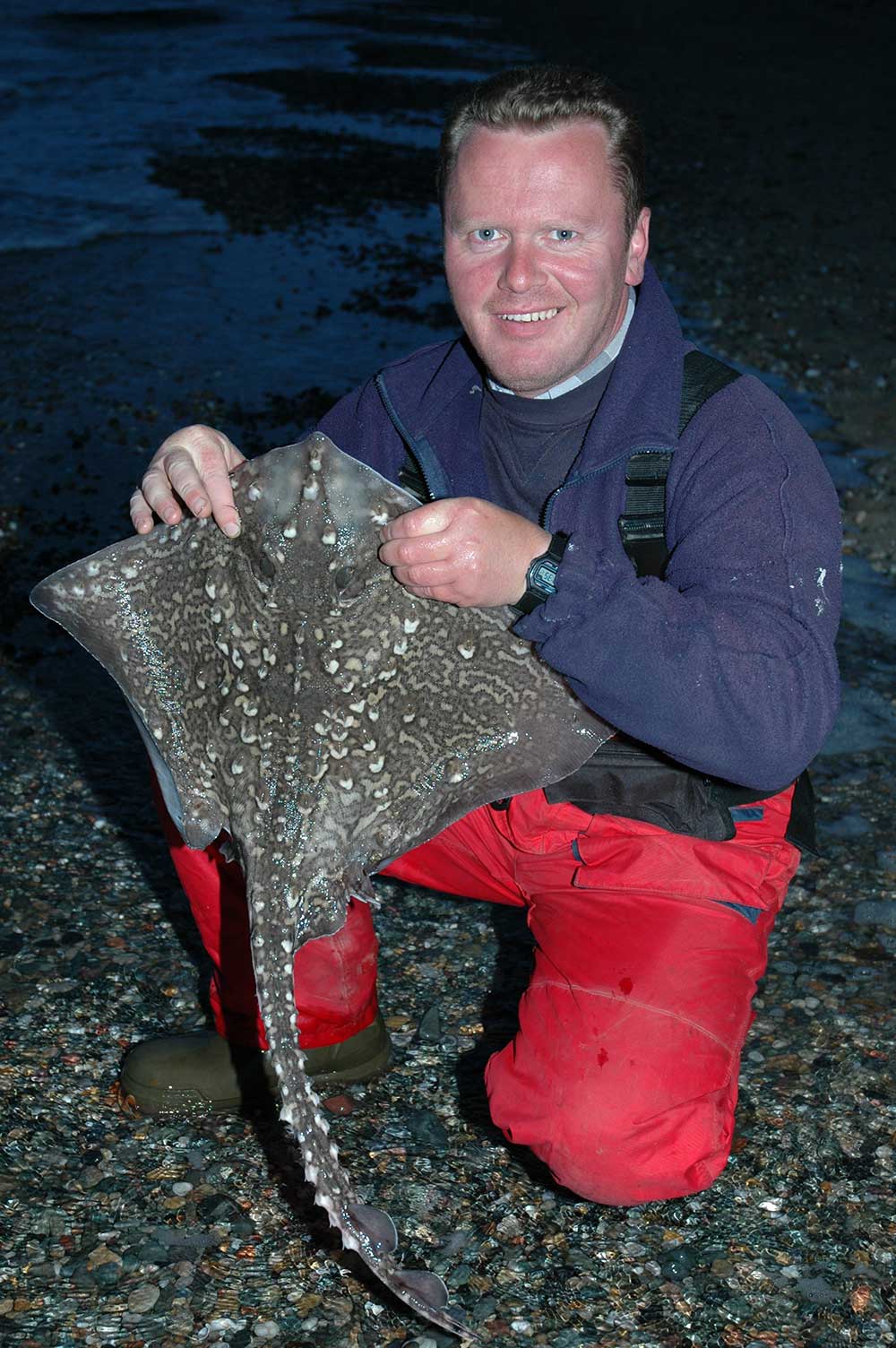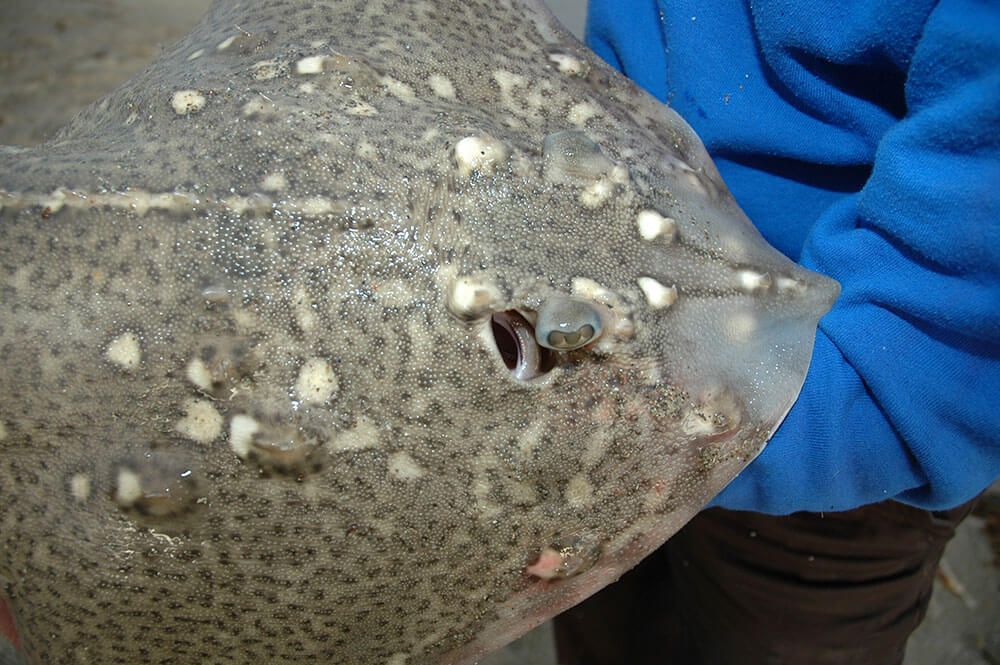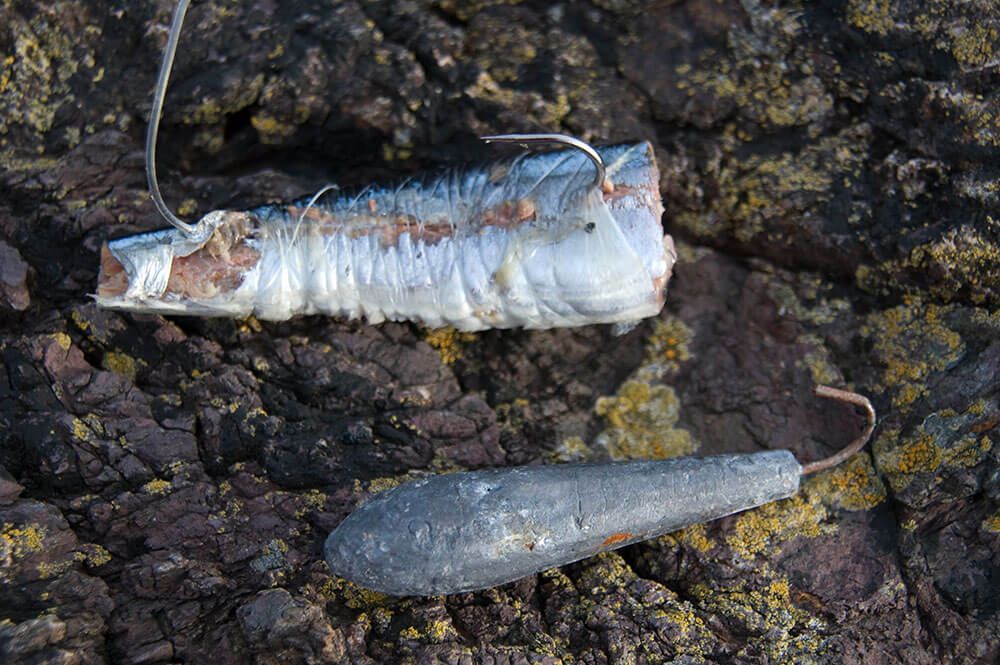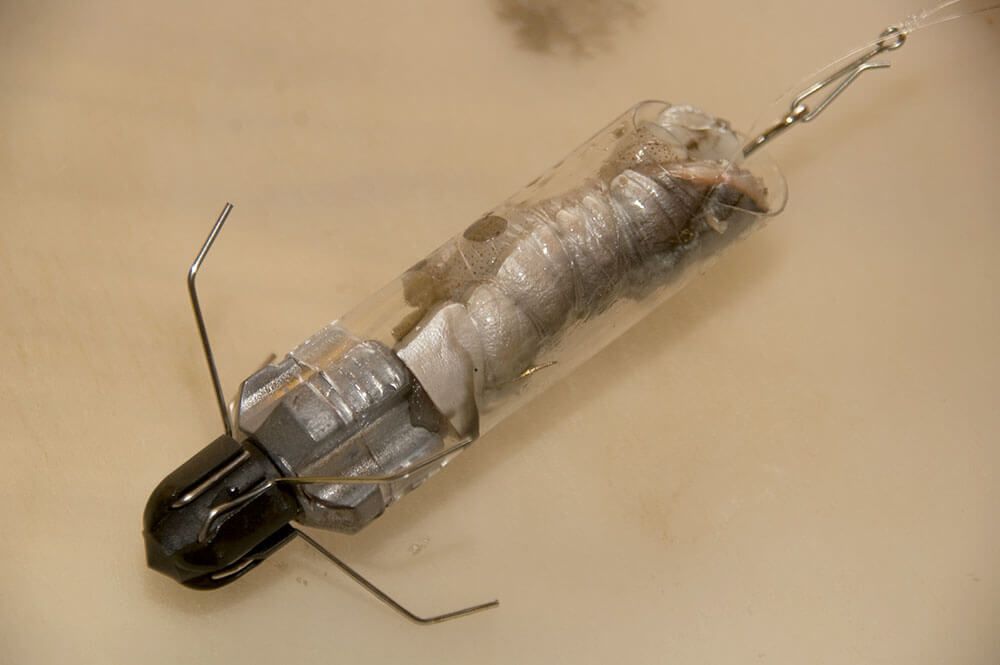Rays are one of our more difficult species to individually identify, as thornbacks, spotted and small-eyed ray can, in some areas, all be caught together. Blonde ray can also be caught off the shore alongside thornbacks.
Rays covered across the back with small defined spots are spotted rays and blonde ray. Small-eyed ray have white or creamy white blotches and lines running across their back. Thornbacks have a short but more pointed nose than the other rays and the angles of the outer wing are at right angles to each other. Thornbacks are, to a greater or lesser extent, covered with thorns across the wings whereas the other rays tend to have the thorns concentrated down the spine and tail and lightly at the forward edges of the wings.
Their colouration on the back is more greyish brown when living on mud, to fawn or sandy brown when on sand with a white/grey belly. Occasionally thornbacks have dark eye shaped roundels on the middle of each wing, and some show a mixed mottling of fawn and darker shades of brown.
Thornbacks breed in the January to May period. Female rays move in to weed beds and reef areas to deposit their eggs in amongst the weed and stones. The eggs are housed in egg sacs referred to as Mermaid’s Purses, these being a common find when walking on the shoreline after the egg has hatched.

The embryo takes from 16 to 20 weeks to hatch. Newly hatched fish are about 3¼ ins in width and as juveniles feed on small shrimps and amphipods.
As adults their diet consists of shrimps, numerous types of crab, small fish such as poor cod, whiting, flatfish and sandeels. When living close to shore thornbacks will also move in to beaches after a heavy storm to feed on broken clams, mussels, razorfish and lugworm.
Thornbacks tend to swim in small groups of three to 7 fish, often one or two females and three or four smaller males being typical. If you catch one ray, you’re more than likely to catch more in quick succession.
WHEN AND WHERE TO FISH
Thornbacks are found throughout the UK and Ireland. Their range also covers as far north as the southern coast of Iceland, up to the middle coastal region of Norway, and south encompassing the whole of the Mediterranean and the northern tip of Africa.
They are commonest on our western facing coasts, but the East Coast beaches and Holderness beaches in south Yorkshire can also produce good numbers of rays at times.
They can be caught from shallow open beaches moving in with the tide and sitting in shallow gutters that run parallel across the beach where food gets deposited or on the inclines of sandbanks where food again gets left by the tide. They also move in to the mouths of our smaller estuaries again favouring sandbanks and deeper channels. Occasionally they can be caught inside larger harbours when casting from breakwaters and harbour walls on to clean ground. Other good marks are rock ledges that give access to deeper water over sand.
On deeper beaches and rock ledges, thornbacks can be caught on any size of tide. On the beaches it’s mainly the bigger spring tides that produce the best results. The middle sized tides rising towards the biggest spring tides are the ones to fish for consistent results. The rays move in with the new flood tide and will travel to the mid tide level, generally speaking, so long casting will often pay when after shallow beach rays. Also try to pick a low tide that falls in the dark.
The vast majority of rays from the shallow beaches will be caught in the hours of darkness. Few are caught in daylight. Off the deeper water marks, especially those with over 50ft of water, then daylight ray fishing is more likely.
A good time to fish for thornies is directly after a storm when the sea is calming down and still coloured. Rays will move tight inshore in these conditions to feed on food exposed by the scouring action of the waves.
There are two main inward migrations of thornbacks. One occurs in the spring triggered by the dropping of the egg sacs by the females and then breeding, but also by the first flush of peeling crabs along the shore. These fish stay close in until mid June or so when they move out.
A secondary migration of rays occurs in September coinciding with the big equinoctial tides. These fish move in with the whiting and they stay until late November in some areas.

RAY TACKLE
Casting distance can be important to reach the rays, and also to lift them up rock ledges when fishing deeper water. This requires a 4-6oz beachcaster with a fast or ultra fast taper action. Lengths vary between 12ft and 14ft, though most anglers find 13ft to 13ft 6in ideal.
Over clean sand fast running multipliers such as the ABU 6500i TSR or the Daiwa 7HT Mag loaded with 15lb line and a 60lb shock leader will get good distance. If you prefer a fixed spool reel go for a larger 8000 sized reel and load the spool to the hilt to maximise casting potential.
In areas where rays need to be brought back across mixed rough ground, and when fishing from deep water rock ledges, then a stronger reel such as the Penn 525Mag2 or ABU 7000 series have the gears and retrieve to bully big fish.
HOW TO BUILD A 1-HOOOK CLIPPED DOWN RAY RIG
THORNBACK BAITS
One of the top baits is a mackerel/squid cocktail. This is simply a 3-inch long by 1-inch wide strip of mackerel, with a strip of squid laid alongside it and bound up with bait elastic. Ray baits do not need to be big.
A 2 to 3-inch section of bluey bait is also excellent as it gives off a massive amount of oil and will draw rays in from far a field. You can also add tippets of squid for extra attraction.

A whole small to medium sized squid is a good ray bait, as is a fillet of poor cod or pout. In spring herring can be a real killer, especially when fresh.
In some areas sandeel baits are good for thornbacks. Use a whole large sandeel cutting the head and tail off, feed the body up the hook and over the hook eye and whip in place with elastic thread leaving the hook point exposed.
In spring peeler crab can be deadly when fishing off the beaches in close proximity to rougher ground.
In the autumn period a lot of thornbacks are caught on lug baits aimed at cod. Simply push two or thee lug up the shank of the hook and tip this with a strip of squid.
After storms thornies will also take razorfish, mussel and clam baits.
TOP TIP 1
Fishing two rods side by side is an advantage when ray fishing. By having two baits in the water in relatively near proximity, when you re bait or catch a fish, the other bait is left out there to keep scent in the water and retains the interest of any other rays moving in to the feeding area you’ve set up.
TOP TIP 2
If you think you may struggle to reach the rays you can use a technique called “lining back”. This requires a big fixed spool reel holding 300yds plus of 15lb line, an 8000 size is ideal. Using chest waders, walk out in to the surf as far as you can and cast out. As the tide floods in, simply keep releasing line as you walk back with the tide. Eventually your bait will be two hundred yards or more out and in ray territory.
TOP TIP 3
The new body 150gm D-Vice is an excellent way to gain a little extra casting distance, plus it maintains good bait presentation. You can also cut up some small chunks of mackerel, literally just 1/4 –inch squares, and put a few of these in to the base of the tube before you slide in the main hook bait. When the D-Vice hits the seas surface, out pops the bait followed by the small mackerel squares. These then float off downtide and give you a little groundbait to help attract the rays in towards the main bait.

TOP TIP 4
Always study a beach before fishing at low water. Look for the deeper areas and those parallel gutters will certainly hold any rays as they move inshore. Also watch the surf as it breaks. Areas where the surf breaks closer in are deeper and these are the hotspots to try as the tide floods in.
TOP TIP 5
In many areas, especially along the Holderness coast and off the Welsh coast, big shrimps, prawns and uncooked Tiger prawn from the supermarket make great baits. Just slide the prawn up the hook tail first, then place another one alongside it and secure with bait elastic.
Rays covered across the back with small defined spots are spotted rays and blonde ray. Small-eyed ray have white or creamy white blotches and lines running across their back. Thornbacks have a short but more pointed nose than the other rays and the angles of the outer wing are at right angles to each other. Thornbacks are, to a greater or lesser extent, covered with thorns across the wings whereas the other rays tend to have the thorns concentrated down the spine and tail and lightly at the forward edges of the wings.
Their colouration on the back is more greyish brown when living on mud, to fawn or sandy brown when on sand with a white/grey belly. Occasionally thornbacks have dark eye shaped roundels on the middle of each wing, and some show a mixed mottling of fawn and darker shades of brown.
Thornbacks breed in the January to May period. Female rays move in to weed beds and reef areas to deposit their eggs in amongst the weed and stones. The eggs are housed in egg sacs referred to as Mermaid’s Purses, these being a common find when walking on the shoreline after the egg has hatched.

The embryo takes from 16 to 20 weeks to hatch. Newly hatched fish are about 3¼ ins in width and as juveniles feed on small shrimps and amphipods.
As adults their diet consists of shrimps, numerous types of crab, small fish such as poor cod, whiting, flatfish and sandeels. When living close to shore thornbacks will also move in to beaches after a heavy storm to feed on broken clams, mussels, razorfish and lugworm.
Thornbacks tend to swim in small groups of three to 7 fish, often one or two females and three or four smaller males being typical. If you catch one ray, you’re more than likely to catch more in quick succession.
WHEN AND WHERE TO FISH
Thornbacks are found throughout the UK and Ireland. Their range also covers as far north as the southern coast of Iceland, up to the middle coastal region of Norway, and south encompassing the whole of the Mediterranean and the northern tip of Africa.
They are commonest on our western facing coasts, but the East Coast beaches and Holderness beaches in south Yorkshire can also produce good numbers of rays at times.
They can be caught from shallow open beaches moving in with the tide and sitting in shallow gutters that run parallel across the beach where food gets deposited or on the inclines of sandbanks where food again gets left by the tide. They also move in to the mouths of our smaller estuaries again favouring sandbanks and deeper channels. Occasionally they can be caught inside larger harbours when casting from breakwaters and harbour walls on to clean ground. Other good marks are rock ledges that give access to deeper water over sand.
On deeper beaches and rock ledges, thornbacks can be caught on any size of tide. On the beaches it’s mainly the bigger spring tides that produce the best results. The middle sized tides rising towards the biggest spring tides are the ones to fish for consistent results. The rays move in with the new flood tide and will travel to the mid tide level, generally speaking, so long casting will often pay when after shallow beach rays. Also try to pick a low tide that falls in the dark.
The vast majority of rays from the shallow beaches will be caught in the hours of darkness. Few are caught in daylight. Off the deeper water marks, especially those with over 50ft of water, then daylight ray fishing is more likely.
A good time to fish for thornies is directly after a storm when the sea is calming down and still coloured. Rays will move tight inshore in these conditions to feed on food exposed by the scouring action of the waves.
There are two main inward migrations of thornbacks. One occurs in the spring triggered by the dropping of the egg sacs by the females and then breeding, but also by the first flush of peeling crabs along the shore. These fish stay close in until mid June or so when they move out.
A secondary migration of rays occurs in September coinciding with the big equinoctial tides. These fish move in with the whiting and they stay until late November in some areas.

RAY TACKLE
Casting distance can be important to reach the rays, and also to lift them up rock ledges when fishing deeper water. This requires a 4-6oz beachcaster with a fast or ultra fast taper action. Lengths vary between 12ft and 14ft, though most anglers find 13ft to 13ft 6in ideal.
Over clean sand fast running multipliers such as the ABU 6500i TSR or the Daiwa 7HT Mag loaded with 15lb line and a 60lb shock leader will get good distance. If you prefer a fixed spool reel go for a larger 8000 sized reel and load the spool to the hilt to maximise casting potential.
In areas where rays need to be brought back across mixed rough ground, and when fishing from deep water rock ledges, then a stronger reel such as the Penn 525Mag2 or ABU 7000 series have the gears and retrieve to bully big fish.
HOW TO BUILD A 1-HOOOK CLIPPED DOWN RAY RIG
THORNBACK BAITS
One of the top baits is a mackerel/squid cocktail. This is simply a 3-inch long by 1-inch wide strip of mackerel, with a strip of squid laid alongside it and bound up with bait elastic. Ray baits do not need to be big.
A 2 to 3-inch section of bluey bait is also excellent as it gives off a massive amount of oil and will draw rays in from far a field. You can also add tippets of squid for extra attraction.

A whole small to medium sized squid is a good ray bait, as is a fillet of poor cod or pout. In spring herring can be a real killer, especially when fresh.
In some areas sandeel baits are good for thornbacks. Use a whole large sandeel cutting the head and tail off, feed the body up the hook and over the hook eye and whip in place with elastic thread leaving the hook point exposed.
In spring peeler crab can be deadly when fishing off the beaches in close proximity to rougher ground.
In the autumn period a lot of thornbacks are caught on lug baits aimed at cod. Simply push two or thee lug up the shank of the hook and tip this with a strip of squid.
After storms thornies will also take razorfish, mussel and clam baits.
TOP TIP 1
Fishing two rods side by side is an advantage when ray fishing. By having two baits in the water in relatively near proximity, when you re bait or catch a fish, the other bait is left out there to keep scent in the water and retains the interest of any other rays moving in to the feeding area you’ve set up.
TOP TIP 2
If you think you may struggle to reach the rays you can use a technique called “lining back”. This requires a big fixed spool reel holding 300yds plus of 15lb line, an 8000 size is ideal. Using chest waders, walk out in to the surf as far as you can and cast out. As the tide floods in, simply keep releasing line as you walk back with the tide. Eventually your bait will be two hundred yards or more out and in ray territory.
TOP TIP 3
The new body 150gm D-Vice is an excellent way to gain a little extra casting distance, plus it maintains good bait presentation. You can also cut up some small chunks of mackerel, literally just 1/4 –inch squares, and put a few of these in to the base of the tube before you slide in the main hook bait. When the D-Vice hits the seas surface, out pops the bait followed by the small mackerel squares. These then float off downtide and give you a little groundbait to help attract the rays in towards the main bait.

TOP TIP 4
Always study a beach before fishing at low water. Look for the deeper areas and those parallel gutters will certainly hold any rays as they move inshore. Also watch the surf as it breaks. Areas where the surf breaks closer in are deeper and these are the hotspots to try as the tide floods in.
TOP TIP 5
In many areas, especially along the Holderness coast and off the Welsh coast, big shrimps, prawns and uncooked Tiger prawn from the supermarket make great baits. Just slide the prawn up the hook tail first, then place another one alongside it and secure with bait elastic.

